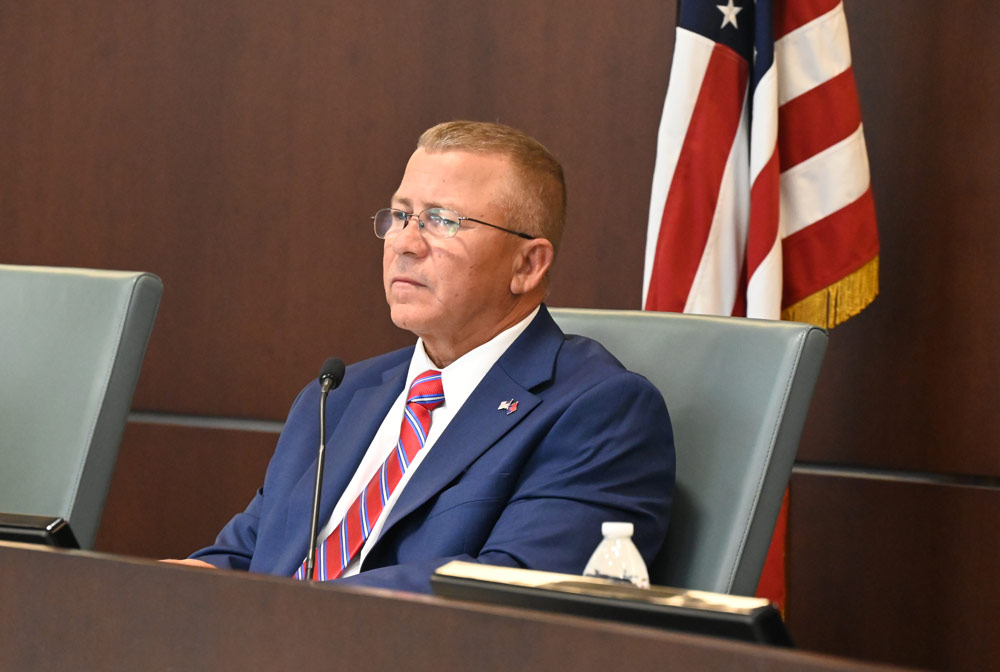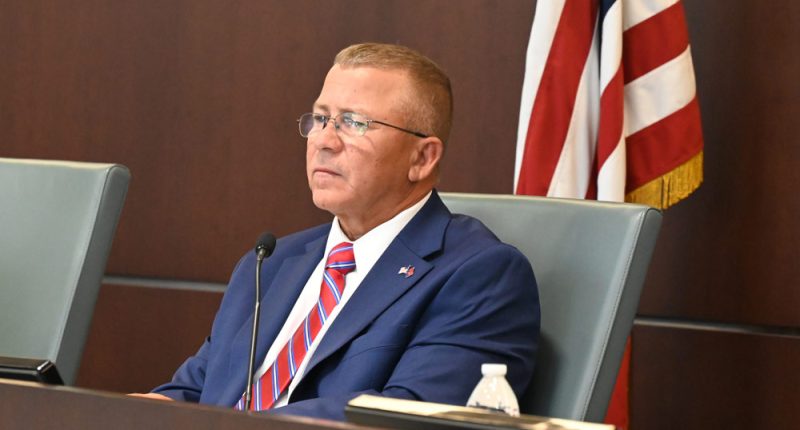
In a stunning reversal, Palm Coast Mayor Mike Norris today told his colleagues that he will vote against the utility rate increase and borrowing plan he supported just three days ago unless the city imposes an indefinite building moratorium on residential housing, or “no more approval of any more residential housing, to date uncertain,” as he put it.
On Tuesday, Norris was part of the 3-1 majority that approved a $615 million spending plan that includes a 36 percent water and sewer rate increase over the next 30 months. The second read of the ordinance is scheduled for March 18. Norris told his colleagues they have until then to “marinate” in his proposal, which drew sharp resistance from Council members Charles Gambaro and Ty Miller, and guarded support–and an alternative path–from Theresa Pontieri, who twice before had called for a moratorium.
There were no decisions. Norris was only giving his colleagues–and the community–a heads-up. But the council agreed to debate alternatives at length, with evidence, at its workshop next Tuesday. Today’s meeting however boxed Norris into a position from which he could not easily extricate himself. Today’s move potentially sets up a council deadlocked over a utility plan that either collapses or emerges in shredded bits that save face more than infrastructure.
Norris, who had summoned a shellshocked Jason DeLorenzo to the podium to answer his questions, asked the chief of staff how many housing units have been permitted but not built. 19,000, came the answer. If all those units were built and occupied today, would the utility infrastructure support them?
“No, sir,” DeLorenzo told the mayor, also noting that when ITT began building Palm Coast, it platted 45,000 lots but did not have the infrastructure capacity to accommodate all 45,000, since it would be built up as the houses were built. ( ITT’s oldest sewer plant, what is today Wastewater Treatment Plant 1 in the Woodlands, began in 1971 as a 300,000 gallons-per-day facility. It is now at 6.83 million gallons per day, with a further expansion planned, assuming the council approves paying for it.)
Norris then asked if the city went through with the bonding plan and the rest of it, “would we have enough water and wastewater to sustain those houses, once those other [19,000], if they came fully online?”
“No, sir,” DeLorenzo said–a shocking revelation and news to most.
“OK. So everyone, see our dilemma here? We are never going to catch up, and it’s always going to fall on the back of our residents,” Norris said.
Norris last Tuesday voted with the 3-1 majority to approve an ambitious utility plan that would raise water and sewer rates 36 percent by October 2027 and allow for a pair of bonds totaling $455 million by 2028 to expand and upgrade the water and sewer utility system. The vote was on the ordinance’s first reading.
“So I can tell you right now in open forum, when we come back for the second vote on that, I will be a no vote unless we put in a building moratorium on residential housing,” he said. “We’re not going to keep building on something that we can’t sustain and putting it on the back of our residents. They don’t deserve it. I don’t deserve it. Nobody in this room deserves it. So either the developers are going to start doing industrial growth to bring in jobs, offset our tax base, or we’re going to stop doing houses altogether. When I propose it I will say to a date uncertain. Now, I know I’m going to get pushback–‘we can’t stop building, we can’t stop building.’ Well, if we don’t stop building, we’re going to be broke, and we’re going to force lifetime residents of Florida, Flagler County, to flee their homes, because they cannot afford to live in this state anymore. Plain and simple. Like I said, we are at an inflection point, and we need to fix it.”
It wasn’t clear how residents would be forced to flee if the city continued building.
“If you place a moratorium in place, you’re going to not enable our city to fix these projects,” Gambaro said. “It’s not all bond. These impact fees play a major role in our ability to move forward. That’s one, and then the impact on skilled workers, laborers in our community. Do we put them out of work by doing this? Do we create an unemployment issue, Mr. Mayor, for our community?”
Annamaria Long, executive officer of the Flagler County Home Builders Association, had no idea of this morning’s development until she started getting texts alerting her. “It’s not only the worst outcome for my industry, it’s the worst outcome for every citizen in Palm Coast, for every resident,” Long said of a moratorium. She said the utility rate study that preceded the proposal the city voted on Tuesday is predicated on coming impact fees and growth, which means new housing. “That’s about one-third of the formula,” Long said. Removing it from the equation will increase utility bills “exponentially.”
Long doesn’t question that Palm Coast’s water infrastructure is failing. She said there are water-line breaks every week, costing the city $100,000 a break to repair. “If you stop building today those water and sewer main breaks are still going to happen, you’re just not going to get any more impact fees to pay for the expansion you still need per DEP,” Long said, referring to the Division of Environmental Protection’s consent order. “The impact fees cannot be used for [repair and rehabilitation], and R&R is what the city needs in order to rectify a majority of the problem.”
Long, who is preparing to address the council at coming meetings, strongly objected to the mayor claiming that “developers have been taking advantage of this city far too long.”
“If you ask the developers, I believe the developers would say they’re regularly taken advantage of by the city in terms of regulatory fees, timelines that drag out their process, extensive review fees” forcing them to pay thousands of dollars for each plan review, Long said.
The council is without a fifth vote until mid-April, since Ray Sevens resigned. If the council splits in a 2-2 vote on March 18, the utility plan fails. That would send shock waves to the state, which has Palm Coast’s main sewer plant under a consent order, forcing the city to improve it; to investors, who may hesitate before crafting development plans even without a moratorium; and most damagingly to the city’s financial health, to bond holders (the city still owes $155 million in debt, the bulk of it from the utility), who may question the city’s stability and downgrade its bond rating.
The moratorium would not apply to the 7,500-odd so-called “infill lots” of the original ITT-platted Palm Coast, or “anything that’s in the queue that has been approved,” Norris said, which adds up to 19,000 housing units. It would apply to new development applications, though Norris was not clear on what that meant when his colleagues asked beyond confirming that it would apply to the “western expansion,” the vast empty land beyond U.S. 1 and a county enclave. But development there is not due for several years yet, and major subdivision development in Palm Coast has slowed considerably, so the threat of a moratorium may not amount to more than noise.
Pontieri is asking for a significantly scaling back utility spending plan, “and we come back with a more reasonable ask, so that we’re not laying this entire bomb at the feet of our residents,” she said. “And if we need to consider a moratorium, because that is not an alternative that is presented to us, then that’s what we need to consider.”
“We have been crop-dusted, period. The time to take corrective action unfortunately leaves us with these very drastic measures,” Pontieri said. “We’re not the only ones that are encountering this. The whole state of Florida I would say, by and large, are having these same conversations, and we’ve seen moratoriums get instituted even lately across the state. ”
She’s right. Moratoriums are not as alien as they may seem. Zephyrhills has had one since 2023. Edgewater approved a year-long moratorium in January. The same month, New Smyrna Beach extended one for Venetian Bay, a 2,000-home subdivision. The Juno Beach planning board unanimously backed a year-long moratorium last month, albeit on apartments and commercial developments only. Since last summer moratoriums have been considered in St. Pete Beach, Dundee and Manatee County. Collier and Volusia counties considered and rejected moratoriums.
To Pontieri. Norris’s moratorium does not sound like much of one. “Respectfully, mayor, the ITT lots are what contribute to the issues with Wastewater Treatment Plant 1,” she told him. “So if we excluded those from the moratorium, you’re not helping that situation much.” (The majority of ITT lots’ sewer flows to Waste Water Treatment Plant 1 in the Woodlands, which is under a state consent order to be expanded and upgraded.) She was also dubious about halting development of the western part of the city.
Pontieri would scrap the $455 million bonds, “and then we put pressure on staff, or whoever is pursuing our grants, our lobbyists and our state representatives, to get us the funding.” But that hope had the ring of Xanadu: Sen. Tom Leek, the Volusia Republican and Flagler County’s senior legislator, has repeatedly cautioned local officials that state appropriations will be scarce, and nowhere near the levels Flagler County enjoyed in the last two years. But even in those two flush years, replacing $455 million with state grants would have been an outlandish proposition: Palm Coast’s entire state appropriations over two years totaled about $150 million, and that was with its own representative, Paul Renner, as Speaker of the House. It now has an unknown freshman in his place.
But Pontieri was also on solid ground when she ridiculed the administration’s claim that raising rates now means no rate increase will be needed other than inflation increases past 2027. Administrations have been making that promise almost since the time the city bought the utility in 2003. The promise has never been true, and both mathematically and economically (since recessions are inevitable, reducing impact fee revenue and revenue from growth), it is almost certainly not true for years past 2027.
Miller wants a workshop to discuss any alternatives. “We’re proposing an alternative, but the details aren’t there,” he said, “to look at it and be able to try to make a decision and see what the impacts are and how that’s going to affect our community.” To Gambaro, the discussion of a moratorium should be separate from the discussion and vote on rate increases.
“We are sitting at a 2-2 vote right now, and our residents are mad as hell,” Norris said. “They hate us. And I get the brunt of it because I’m sitting in this chair.”
“We get it as well,” Miller reminded him, his words as if comparing spines.









